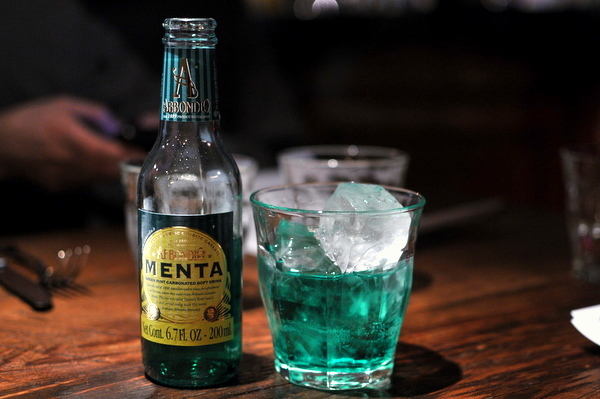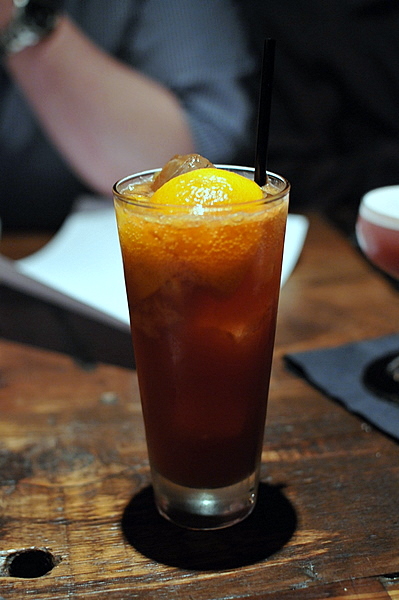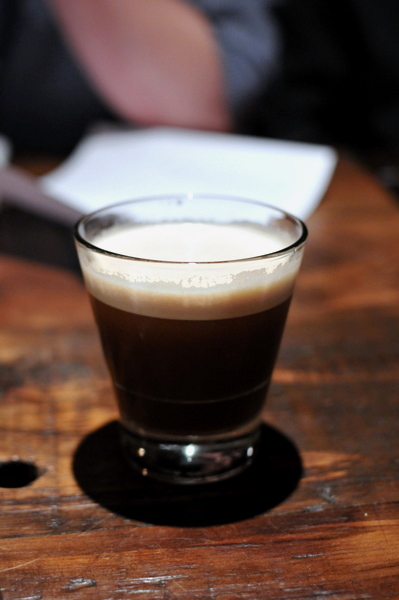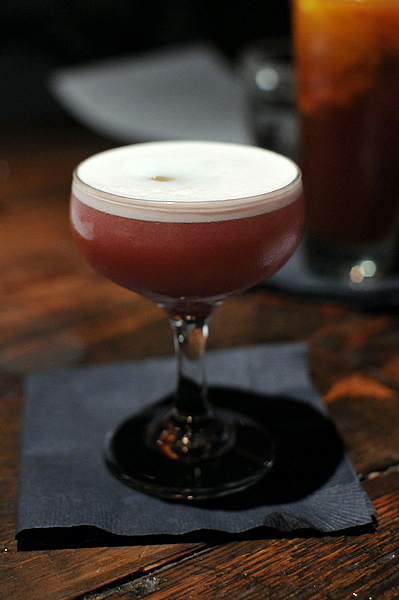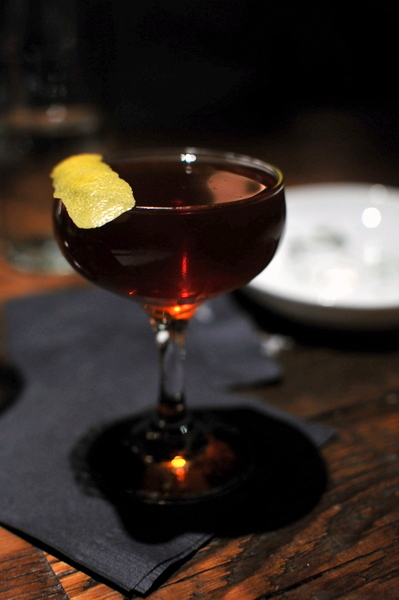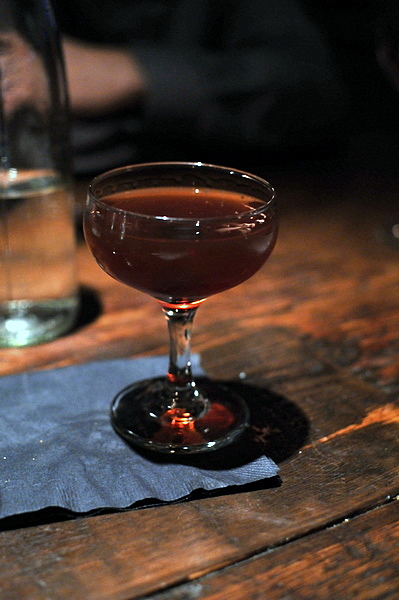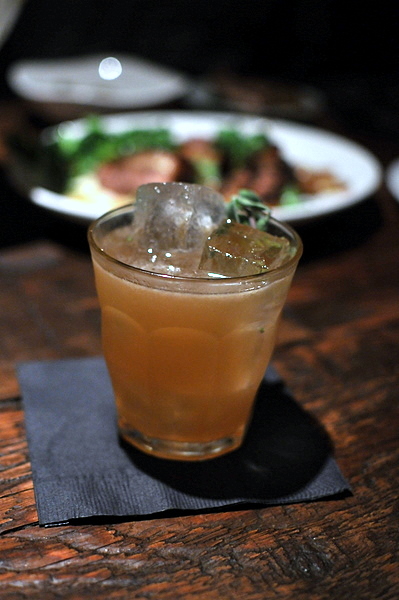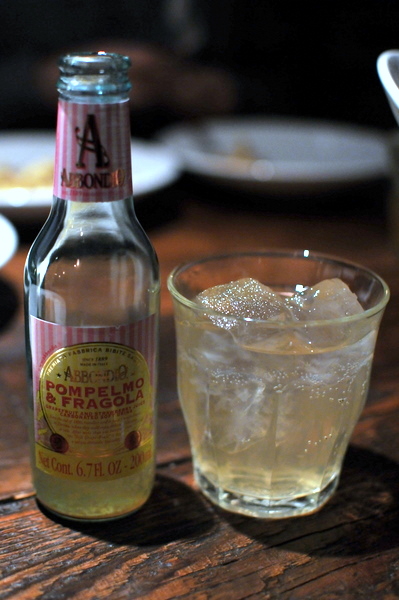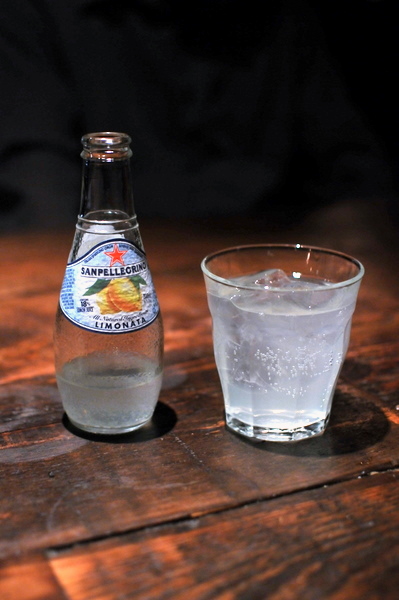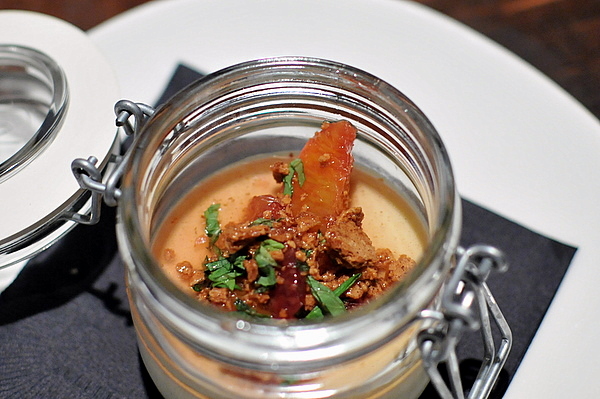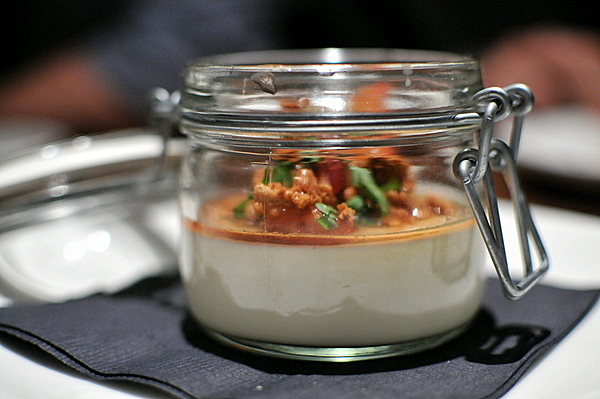Pheast, a relative newcomer to the underground scene is headed by Isaiah, a self-taught chef who discovered his passion for cooking as a means to escape a background of "food stamps and poverty." He was first exposed to spontaneous multi-course menus while working as a sous chef and apparently it made an impression; causing him to leave an executive chef position to pursue his vision. Pheast, a traveling underground supper club, also happens to boast one of the more extravagant underground dinners in terms of style, composition, and scope.
pigs nose 5yr scotch whiskey, lemon, orange, clove sugar
The meal began with a welcome cocktail from our host Nick who in addition to being a superlative bartender, makes his own liqueurs and cheeses which we would try later in the evening. The cocktail has a fragrant spiced nose that exudes a calming warmth but on the palate the drink is remarkably light and refreshing with the orange and lemon juices taking over with a tinge of heat from the whiskey.
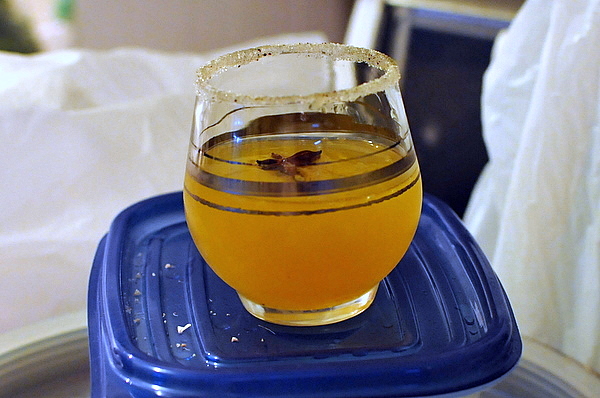
01: clam, uni, dashi, sesame, zucchini, cucumber
I found this to be a very challenging dish, I like the creativity but struggled to appreciate the dish as a whole. Naturally the clams, uni, and dashi pair nicely their brine playing off one another. The sesame was more ambiguous, adding a pleasing textural element but also imparting a nutty sweetness that clashed with the flavor of the shellfish. In the end I was waiting for one flavor to really take control and dictate the course of the dish.

02: yuba, nasturtium, edamame, english pea, lavender, yuzu
The flavor here is definitely driven by the pea and edamame, sweet and vegetal but a bit austere on their own. The lavender adds a soothing floral aroma while a subtle current of yuzu underscores the dish and really electrifies the other flavors. Though I'm not normally a fan of yuba, it was vital here, adding much needed substance to the dish. Individually the components of this dish aren't particularly exciting but taken together the flavor is bright, fresh, and soothing. I would have liked to see a preparation using the yuba to encapsulate the ingredients into a single bite amuse.

03: bouquet of greens with soil
I generally disdain vegetable courses but the individuality that goes into gargouillou style dishes never fail to excite. The sweetness of the Weiser Farms carrots is balanced by the crisp bitter greens while the soil was a salty-sweet blend of hazelnut, chicory, and almond. The dish also came with a shot glass full of carrot-yuzu vinaigrette that we could either drizzle over the garden or sip between bites.

04: artichoke heart, veal sweetbread, shiso, mango, longpepper mayo
The tempura sweetbreads were absolutely delicious the slightly creamy texture is wrapped in a fluffy crisp batter and the subtle offaly flavor pairs sublimely with the peppery bite of the mayo as well as the deep fruity sweetness of the mango. The lingering earthy piquancy of the artichoke heart was an effective palate cleanser though I would have preferred to savor the chicken nugget like sapor of the sweetbread just a bit longer.

05: crab, honeydew, tangerine, oat, stinging nettle, butter ice
The alabaster chunks of fresh crab might have looked like the star of the dish but they were actually overshadowed by the lush honeydew and redolent pink peppercorn. The side of oats was a nice touch giving a dry starchy weight to contrast the levity of the crab and honeydew.

06: chicken, momofuku xo sauce, sugar snap, noodle
After so many light courses it was nice to finally get something with some substance. The chicken was roasted very nicely, moist with an even flavor throughout. The addition of the crisp sugar snap peas and XO gave the dish a decidedly Asian flavor. I would have liked the XO to be more evenly distributed in the pasta to give the noodles a more consistent salinity.

07: crispy lamb rillettes, fingerling confit, pickled chanterelle, arugula
This seemed to be a table favorite, and could be enjoyed any number of ways. The brazenly rich sapid fried rillette stood on its own but also paired nicely with a set of sides expertly chosen to temper the lamb. The potatoes added a starchy heft while the vegetable and chanterelle provided bitterness and an earthy tang respectively. Most surprising was the presence of the cherries, not particularly sweet on their own but distinctly saccharine in contrast with the intensity of the meat.

08: strawberry, white raspberry, malt, pistachio, honey lavender goat cheese
Isaiah originally planned for a trio of desserts but you know what they say about the best laid plans of mice and men. In addition to some technical difficulties, time was becoming a factor as well. So in the interest of brevity and practicality, Isaiah spontaneously created a single dessert using elements from all three that he originally planned. The ad hoc mixture was surprisingly good with ripe berry sweetness balanced by the savory malt "cookie dough" and the dulcet honeyed tones of the goat cheese.

Just like with Wolvesmouth, I was a bit apprehensive but Pheast turned out to be just that in every sense, the sublime food and easy camaraderie (built over 10 bottles of wine) making this a wonderful, if long evening. While there were some hiccups with the desserts Isaiah's passion enabled him to pull off his ambitious vision.
Throughout the meal we had opportunities to engage the chef and watch him cook. The chef, Isaiah, is a likable mix of boundless energy, culinary brilliance, and self-deprecating humility who clearly loves what he does. Despite only sleeping a handful of hours over the last few days and cooking non-stop for 8 hours, he had energy than we did at the end of the evening. While cooking the chef exudes a sense of calm focus at other times he seems almost restless talking quickly about a myriad of topics but always returning to his one true passion, food. I suspect had he remained a mainstream chef he could have done quite well for himself but he chooses this Bohemian lifestyle because it allows him free reign to exercise his creativity; in many ways he reminds me of Chef Thornton of Wolvesmouth.
The one warning I will give is to be prepared for a long meal. Isaiah does nearly all the cooking and cleaning himself though this time he had help from a friend, Libry Darusman of Room Forty, who handled plating. The food is well worth the wait; each course was impeccably plated and consistently delicious. To sum things up, email Isaiah and get yourself a seat while you can, I predict in another couple of months they will be nigh impossible to obtain.

Read more.


























